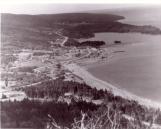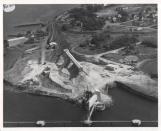22
IMPACT ON MULGRAVE BLEAK - Under the newspaper headline, "Progress Forges Ahead, The Old Bows to the New" in May 1955, this picture was beside the one of the last run of the train ferry across the Strait of Canso and the railway vice president at the ribbon cutting ceremony of the first official train to cross the Canso Causeway.The future looked bleak for the families in these small communites who had relied on the ferries and railroad for their livelihood for over fifty years.
23
Port Hastings village looking north towards Canal and Causeway1958
Port Hastings, Inverness County, Nova Scotia, Canada

24
JOBS IN TOURISM AND TOLL BOOTHS1955- 1959 - New jobs were created at the Canso Canal and Toll Booths on the Canso Causeway.
Formerly a small peaceful village, Port Hastings suddenly became a focal point in the Trans Canada Highway.
There was an increase in tourism traffic and the Tourist Bureau which had been at the car ferry dock in Port Hawkesbury was moved to Port Hastings. It has been expanded over the years but still welcomes thousands of visitors to Cape Breton Island in 2005, fifty years after the opening of the Canso Causeway.
26
LADIES CHURCH GROUP MEET - In 1958, the ladies of St. David's United Church in Port Hastings which stands as a welcoming beacon to everyone driving onto Cape Breton Island, were carrying on as usual. The W.M.S. or Women's Missionay Society were having their meeting on the front lawn of the church manse on Brown Street on the hill above the church.Cape Porcupine from which a little more than 10 million tons of rock were quarried to build the deepest man made causeway in the world,the Canso Causeway, can be seen on the mainland side of the Strait of Canso.
27
Community looking north from Cape Porcupine1953
Auld's Cove, Guysborough County, Nova Scotia, Canada

28
AULD'S COVE - Many Auld's Cove residents worked with the various companies involved in the construction of the Canso Causeway and some stayed on as company employees even after it was completed in 1955.Once the Canso Causeway became a reality, a number of new businesses opened in Auld's Cove to provide services to travellers. Some residents continued to make a living by fishing.
By 1978, quarrying would begin again at Cape Porcupine and continues to the present. Rock is loaded onto bulk carriers or barges and shipped down as far as Bermuda. Jobs are created at the concrete plant as well.
30
1959- July 7th, THE 4 COUNTY CITIZEN, The Voice and Views of the Four Strait Counties in it's first edition carried this and many more articles such as "Causeway Proves Key to Area's Development, 4 Counties Move From Curio Stage to Industrial Progress and Deed to Mill Site to be Turned Over at Meeting July 8."Perseverance had paid off for the Four Counties Development Association when Nova Scotia Pulp Limited invested $40 million to build a new bleached sulphite pulp mill in Point Tupper,Richmond County. This was 6 years after the formation of the Four Counties Industrial Development Association under the dedicated and passionate leadership of Leonard O'Neil, Mayor of Mulgrave.
32
PULP MILL COMES FIRST - 1959- 1962 - Nova Scotia Pulp Limited, owned by Stora Kopparberg of Sweden and initially Scott Paper Limited of Philadelphia, invested $40 million dollars when they built their sulphite pulp mill in the Strait of Canso. It had its official opening on January 2nd, 1962 and went into regular production at their Point Tupper mill on Feb1st. They employed 400 at the plant and another 800 full time jobs were to be found in Eastern Nova Scotia harvesting and trucking of wood.34
BESTWALL GYPSUM - Nova Scotia Bestwall Gypsum Division of Georgia Pacific Corporation started operations of a gypsum shipping pier at Point Tupper, Richmond County in 1962. Their shipping pier was constructed in the same area where train ferries had docked up until 1955. That year the Canso Causeway was completed. The Causeway had blocked the huge cakes of ice that came down from the Gulf of St. Lawrence every winter on the north side of it. This had created the very deep, year round ice free waterway on the Point Tupper side.Their mining operation was twenty five miles away at River Denys, Inverness County.They moved to their Sugar Camp site in 1992 and to Melford, Inverness County in 2003.
They and Nova Scotia Pulp Ltd.(now Stora Enso Port Hawkesbury) have been providing employment in the Strait of Canso since 1962.




